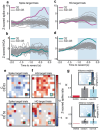This is a preprint.
Active Dissociation of Intracortical Spiking and High Gamma Activity
- PMID: 40672280
- PMCID: PMC12265708
- DOI: 10.1101/2025.07.10.663559
Active Dissociation of Intracortical Spiking and High Gamma Activity
Abstract
Cortical high gamma activity (HGA) is used in many scientific investigations, yet its biophysical source is a matter of debate. Two leading hypotheses are that HGA predominantly represents summed postsynaptic potentials or-more commonly- predominantly represents summed local spikes. If the latter were true, the nearest neurons to an electrode should contribute most to HGA recorded on that electrode. We trained subjects to decouple spiking from HGA on a single electrode using a brain-machine interface. Their ability to decouple them indicated that HGA is not primarily generated by summed local spiking. Instead, HGA correlated with neuronal population co-firing of neurons that were widely distributed across millimeters. The neuronal spikes that contributed more to this co-firing also contributed more to, and preceded, spike-triggered HGA. These results suggest that HGA arises predominantly from summed postsynaptic potentials triggered by synchronous co-firing of widely distributed neurons.
Figures







Similar articles
-
Comparison of Two Modern Survival Prediction Tools, SORG-MLA and METSSS, in Patients With Symptomatic Long-bone Metastases Who Underwent Local Treatment With Surgery Followed by Radiotherapy and With Radiotherapy Alone.Clin Orthop Relat Res. 2024 Dec 1;482(12):2193-2208. doi: 10.1097/CORR.0000000000003185. Epub 2024 Jul 23. Clin Orthop Relat Res. 2024. PMID: 39051924
-
Signs and symptoms to determine if a patient presenting in primary care or hospital outpatient settings has COVID-19.Cochrane Database Syst Rev. 2022 May 20;5(5):CD013665. doi: 10.1002/14651858.CD013665.pub3. Cochrane Database Syst Rev. 2022. PMID: 35593186 Free PMC article.
-
Sexual Harassment and Prevention Training.2024 Mar 29. In: StatPearls [Internet]. Treasure Island (FL): StatPearls Publishing; 2025 Jan–. 2024 Mar 29. In: StatPearls [Internet]. Treasure Island (FL): StatPearls Publishing; 2025 Jan–. PMID: 36508513 Free Books & Documents.
-
123I-MIBG scintigraphy and 18F-FDG-PET imaging for diagnosing neuroblastoma.Cochrane Database Syst Rev. 2015 Sep 29;2015(9):CD009263. doi: 10.1002/14651858.CD009263.pub2. Cochrane Database Syst Rev. 2015. PMID: 26417712 Free PMC article.
-
Audit and feedback: effects on professional practice.Cochrane Database Syst Rev. 2025 Mar 25;3(3):CD000259. doi: 10.1002/14651858.CD000259.pub4. Cochrane Database Syst Rev. 2025. PMID: 40130784
References
Publication types
Grants and funding
LinkOut - more resources
Full Text Sources
